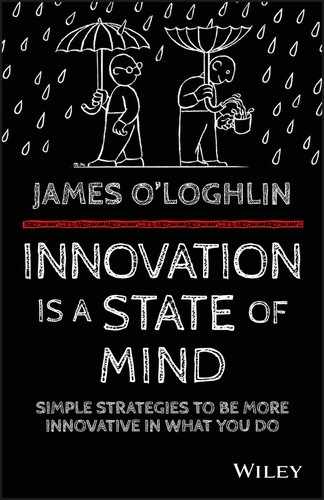Notes
In writing this book, I have drawn on various blog posts and articles I have written over the years, and on keynote presentations I have given on innovation. Other sources include the following.
Preface
Information about the original ABC-TV series The Inventors was obtained from the Australian Screen website.
Throughout the book, information about the inventors and inventions that appeared on The New Inventors came from three sources: my own memory, my notes and the show's own website, accessed through abc.net.au. The website survives to this day (or at least to the date of publication) and has lots of information about all the featured inventors and their inventions so, if you are curious, browse away. There's some great stuff there.
Introduction
Check online for the many definitions of innovation, invention, innovator and inventor.
Chapter 1
I heard Professor Rosabeth Moss Kantor talk about habitual thinking (and many other things) at the Australian Chambers Business Congress in Melbourne on 16 August 2012.
Question everything
The story of Suvir Merchandani and the costs of printer's ink can be found by searching for:
‘India teen tells US how to save $400 million by changing font'
Source: The Hindu
‘Suvir Mirchandani tells US government how to save £240m — just by changing their font'
Source: The Independent
What assumptions are you making?
Information on how Air Canada and IBM enabled customers to view the airline's content on their own device can be found by searching for:
‘Air Canada rouge soars ahead with wireless in-flight entertainment service'
Source: IBM
Is the answer in your data?
The story of Tacoma Zoo analysing weather and attendance can be found by searching for:
‘How a Tacoma Zoo Improved Staffing, Visitor Experience with Big Data'
Source: Building a Smarter Planet
Information on Cincinnati Zoo's analysis of how its visitors spent money is collected in:
‘Business Intelligence Helps the Cincinnati Zoo Work Smarter',
Source: Essentials of Management Information Systems 11th edn, ch. 11, case 4 by Kenneth C. Laudon and Jane P. Laudon (via course materials from Mercer University)
Upworthy's analysis of its readers' habits is discussed in:
‘How Upworthy is using data to move beyond clickbait and curation'
Source: NiemanLab
I became aware of enLighten through my involvement with the Australian Cleantech Competition (later the Australian Technologies Competition), run by that great champion of Australian innovation John O'Brien. Steve Cahill, the CEO of enLighten Australia, kindly reviewed the section on the company.
Think like a customer or client
I first heard of Meat Pack from technology entrepreneur and speaker Mick Luibinskis. The story of Meat Pack's Hijack campaign is found on the thinkwithgoogle website.
Plan for failure
Information on why there are ashtrays in planes is found in:
‘Why Airplanes Still Have Ashtrays in the Bathrooms'
Source: Gizmodo
‘Why aeroplanes still have ashtrays in the bathroom'
Source: Business Insider Australia
‘If You Can't Smoke on Planes, Why Are There Still Ashtrays?'
Source: Mental Floss
Get bored
Dr Sandi Mann and Rebekah Cadman's study on the relationship between boredom and creativity is found in:
‘Does Being Bored Make Us More Creative?'
Source: Creativity Research Journal, vol. 26, no. 2, 2014
Chapter 3
The idea of failing quickly and cheaply has been around for a while. I first heard about it from technology entrepreneur and speaker Mick Luibinskis.
Information on WD-40 was from:
‘John S. Barry, Main Force Behind WD-40, Dies at 84'
Source: New York Times
Chapter 4
Some of the ideas and concepts in this chapter appear in my book Umm . . . a Complete Guide to Public Speaking (Allen & Unwin) and/or have been developed from various pitching and public speaking workshops I have conducted.
Chapter 5
Some of the ideas and concepts in this chapter appear in my previous books and articles, particularly How to Balance your Life (Allen & Unwin).
Chapter 7
Information about Google's 20 per cent innovation time was found at:
‘Google's staff now too busy for 20% time off perk, claim former employees'
Source: Daily Mail Australia
‘Google's Best New Innovation: Rules Around “20% Time”
Source: Forbes, http://www.20timeineducation.com/
‘Google's “20 percent time” in action'
Source: Google Official Blog
